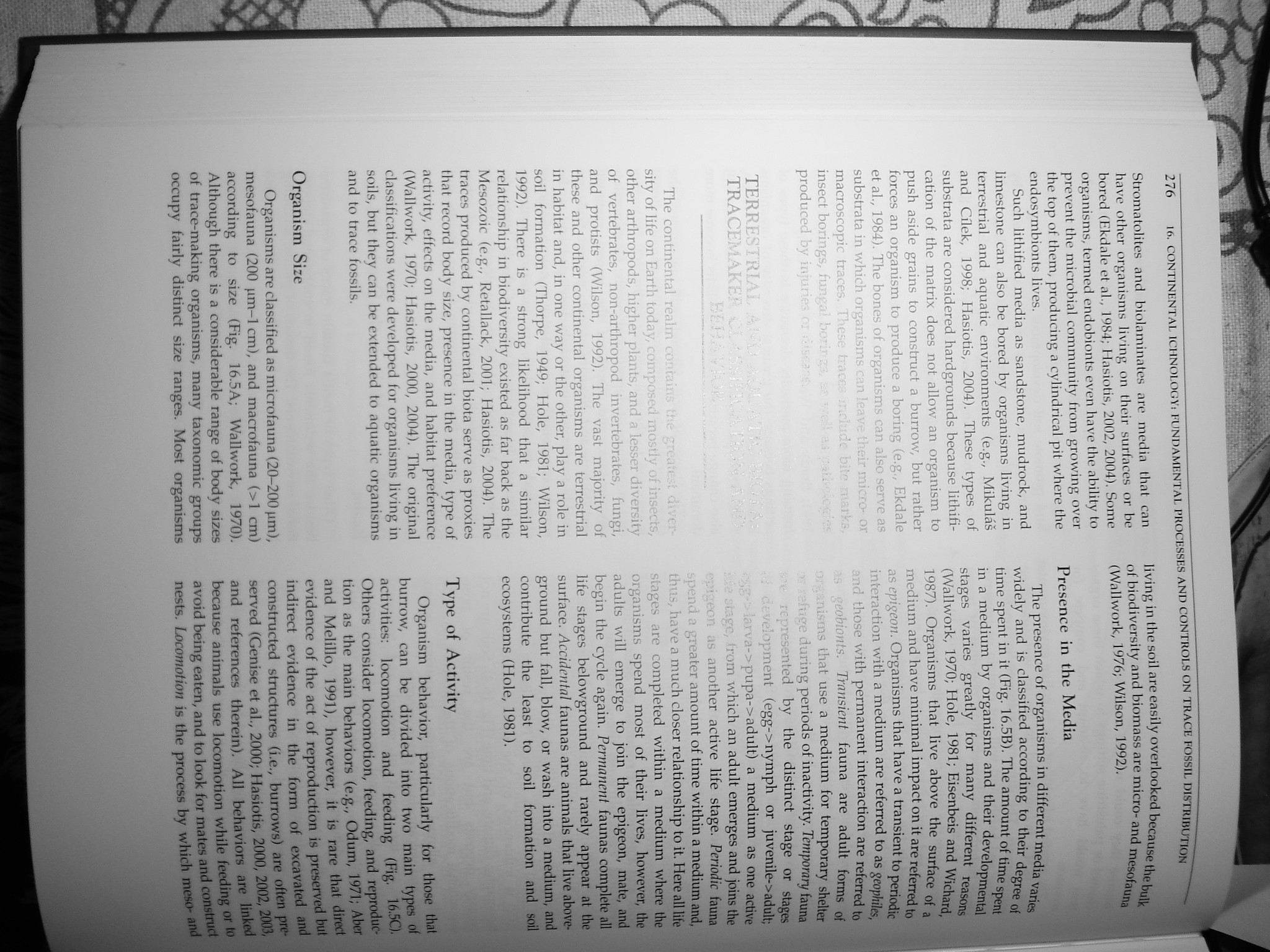dsc08789 (3)

276
16. CONTINENTAL ICHNOLOGYi FUNDAMBNTAL PROCESSES AND CONTROLS ON TRACĘ FOSSIL DISTRIBUTION
Stroma tol i tes and biolaminales are media that can have other organisms living on their surfaces or be bored (Ekdale et al., 1984; Hasiotis, 2002, 2004). Some organisms, termed endobionts even have the ability lo prevent the microbial community from growing over the top of them, producing a cylindrical pit where the endosymbionts lives.
Such lithified media as sandstone, mud rock, and limestone can also be bored by organisms living in terrestrial and aquatic environments (e.g., Mikulaś and Cflek, 1998; Hasiotis, 2004). These types of substrata are considered hardgrounds because lithifi-cation of the matrix does not allow an organism to push aside grains to construct a burrow, but rather forces an organism to produce a boring (e.g., Ekdale et al./1984). The bones of organisms can also serve as substrata in which organisms can leav«? their mi ero- or macroscopic traces. These traces inelude bite marka, insect borings, fungal borings, £? v.re& produced by injuries
TERRESTRIAI
TRACEMAKER Ci■■. '■-/ •
The Continental realm contains the greates; diver-sity of life on Earth today, composed mostly of insects, other arthropods, higher plants, and a lesser diversity of vertebrates, non-arthropod invertebrates, fungi, and protists (Wilson, 1992). The vast majority of these and other Continental organisms are terrestrial in habitat and, in one way or the other, play a role in soil formation (Thorpe, 1949; Hole, 1981; Wilson, 1992). There is a strong likelihood that a similar relationship in biodiversity existed as far back as the Mesozoic (e.g., Retallack, 2001; Hasiotis, 2004). The traces produced by Continental biota serve as proxies that record body size, presence in the media, type of activity, effeets on the media, and habitat preference (Wallwork, 1970; Hasiotis, 2000, 2004). The original classifications were developed for organisms living in soils, but they can be extended to aquatic organisms and to tracę fossils.
Organism Size
Organisms are classified as microfauna (20-200 pm), mesofauna (200 pm-1 cm), and macrofauna (>1 cm) according to size (Fig. 16.5A; Wallwork, 1970). Although there is a considerable rangę of body sizes of trace-making organisms, many taxonomic groups occupy fairly distinct size ranges. Most organisms
living in the soil are easily overlooked because the bulk of biodiversity and biomass are micro- and mesofauna (Wallwork, 1976; Wilson, 1992).
Presence in the Media
The presence of organisms in different media varies widely and is classified according to their degree of time spent in it (Fig. 16.5B). The amount of time spent in a medium by organisms and their developmen(^H stages varies greatly for many different reasons ’ (Wallwork, 1970; Hole, 1981; Eisenbeis and Wichard, \ 1987). Organisms that live above the surface of a medium and have minimal impact on it are referred to as epigeon. Organisms that have a transient to periodk interaction with a medium are referred to as geophiles, ; those with permanent interaction are referred U 1 ńonts. Transient fauna are adult forms of | rns that use a medium for temporary shelter r)V«ge during periods of inactivity. Temporary fauna ented by the distinct stage or stages )pment (egg->nymph or juvenile->adult;
. i va->pupa->adult) a medium as one active Irom which an adult emerges and joins the is another active life stage. Periodic fauna >end a greater amount of time within a medium and, is, ha ve a much closer relationship to it. Here all life stages are completed within a medium where the organisms spend most of their lives, however, the adults will emerge to join the epigeon, matę, and begin the cyde again. Permanent faunas complete all life stages belowground and rarely appear at the surface. Accidental faunas are animals that live above* ground but fali, blow, or wash into a medium, and contribute the least to soil formation and soil ecosystems (Hole, 1981).
Type of Activłty
Organism behavior, particularly for those that burrow, can be divided into two main types of activities: locomotion and feeding (Fig. 16.50. Others consider locomotion, feeding, and reproduc-tion as the main behaviors (e.g., Odum, 1971; Aber and Melillo, 1991), however, it is rare that direct evidence of the act of reproduction is preserved but indirect evidence in the form of excavated and constructed structures (Le., burrows) are often pre* served (Genise et al., 2000; Hasiotis, 2000, 2002,2003, and references therein). All behaviors are linked because animals use locomotion while feeding or to avoid being eaten, and to look for mates and construct nests. Locomotion is the process by which meso- and
Wyszukiwarka
Podobne podstrony:
dsc08794 (2) 278 16. CONTINENTAI. ICHNOLOGYi FUNDAMENTAL PROCESSES AND CONTROLS ON TRACĘ FOSSIL DIST
dsc08779 (2) 70 16. CONTINENTAL ICHNOLOGY: FUNDAMENTAL PROCESSES AND CONTROLS ON T
dsc08786 (3) 274 16. CONTINENTAL ICHNOLOGY: FUNDAMENTA!. 1‘ROCESSES AND CONTROLS ON TRACĘ FOSSIL DIS
dsc08800 (3) 284 16. CONTINENTAL ICHNOLOGY: FUNDAMENTAL PROCESSES AND CONTROLS ON
dsc08787 (3) 274 16. CONTINENTAL 1CHNOLOGY: FUNDAMENTAL PROCESSES AND CONTROLS ON
dsc08776 (3) C H A P T E RContinental Ichnology: Fundamental Processes and Controls on Tracę Fossil
dsc08798 (3) 282 16. CONTINENTAL 1CIINOLOGY: PUNDAMENTAL PROCESSES AND CONTROLS ON TRACĘ FOSSIL DIST
dsc08784 (3) 272 16. CONTINliNTAI. K IINOI.OOYi RJNDAMIINTAI, PH0OUŚBHH ANI) ( ON
dsc08778 (2) FIGURĘ 16.1 Continental realm: biophysicochemical factors. Diagram depicts the and temp
A/CN.9/61 Page 50 NORWAY (continued) Major publications Books and articles on international law and
00017 Y3b1ecbc5ea50e4ab7e2c25f610b9c4 16 Woodall & Faltin Wheeler (199la) and Griffith (1989).
CCF20110228�000 (6) Z plazmą w zębach 16-06-2009 18:20 W najnowszym numerze Plasma Processes and Po/
00216 ?e7b2021092421cf45af4c94abbb03e 218 Baxley where the a, ’s are NID(0, a]) representing random
00394 ?4bf53b90d85a9db56d6772e2aee78a 398 Obenchain Table 4. Yields for Processes with Mean on Targ
00469 ?5193b0eebc921358b059bb4bde7465 475 An Algorithm and a Graphical Approach for Short Run Proce
Tuesday continued hla prowoto •» • Joyar. and *ot tor hit •b*ry aaanacior. (8) FAITH20 8:33 (17)
Liczba cytowan: 2 Cytujący: 1. Horska E.; Oremus P. / 2008 / Processes and problem
więcej podobnych podstron